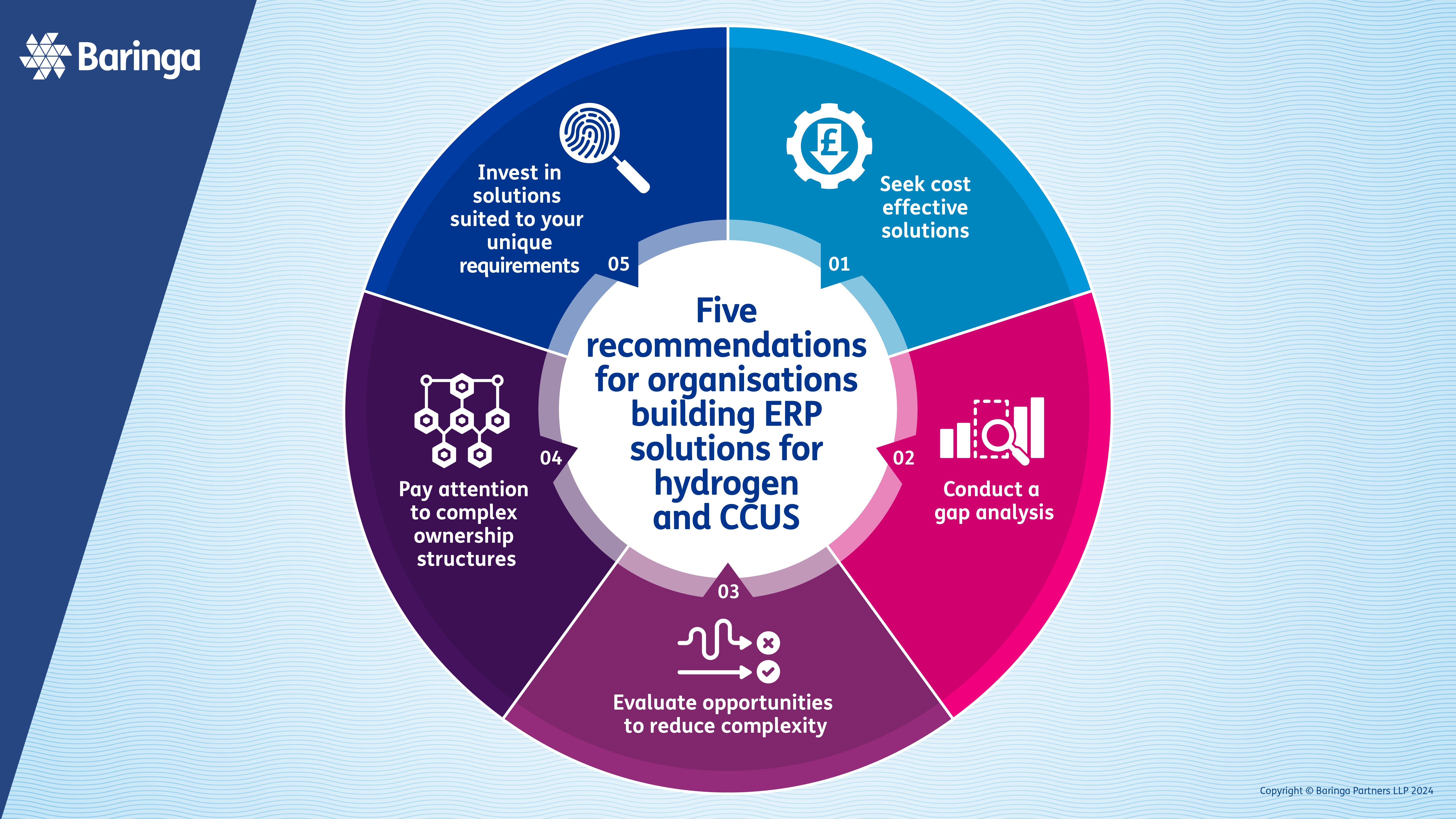
Powering energy’s green future: Five recommendations for building ERP solutions for hydrogen and CCUS
6 min read 17 April 2024
As the world makes the transition to net zero, green hydrogen and carbon capture, utilisation and storage (CCUS) technologies are proving to be a critical stepping stone.
Hydrogen offers short-term opportunities for “greening the grey” and long-term opportunities for decarbonising sectors like aviation and marine, which have been historically difficult to decarbonise. Hydrogen use is on track to expand to more than 500 Mt by 2050. Similarly, the trajectory for CCUS projects is increasing with projected 8 billion tonnes of CO2 captured by 2050, and an estimated US$75-150 billion of capital expenditure required to meet projected demand by 2030.
In the drive towards this green energy future, companies are moving full steam ahead with designing new hydrogen and CCUS value chains, along with the digital systems that power them. But, when they add up all the costs, many are struggling to make attractive business cases.
Key areas of uncertainty that are preventing companies from taking final investment decisions include:
- Demand/market location and timing
- Safety and regulatory frameworks
- Green electron generation location and cost
- Transportation safety and cost
- Government incentives
- Cost of doing business, including enterprise resource planning (ERP) system choices.
Choosing the right digital technologies
Digital technology will be key to powering these new energy value chains. Given the economics of hydrogen and CCUS, a new paradigm is required in both the cost to deploy and operate digital solutions.
When it comes to setting up an ERP system in particular, the good news is that hydrogen and CCUS companies don’t have to start entirely from scratch. Many should be able to draw on solutions developed with oil and gas operators to accelerate the time-to-value for their ERP solutions. At the same time, though, they must keep in mind that the unique characteristics of hydrogen and CCUS value chains.
ERP solution considerations for hydrogen:
- The hydrogen value chain has certain contrasts to that of natural gas. For instance, it is more likely that different parts of the hydrogen value chain might be owned by different parties. This fragmented ownership means that tailored solutions for specific areas might be a better match for hydrogen companies than a single end-to-end ERP system.
- Depending on the activities of the organisation entering into the hydrogen business, it may or may not have an existing ERP setup. It is likely easier to onboard the new hydrogen business onto an existing SAP ERP instance, for example, than to build a new one, even if not fully suitable for the hydrogen value chain.
- The new hydrogen business could be considered as either a start-up/trial venture or an all-out long-term investment. Start-ups should look for a lean and cheap ERP system that grows with the business, while large-scale, longer-term projects will need a more robust, enterprise-grade solution.
- As a relatively new business, green hydrogen comes with unique requirements like Guarantees of Origin (GOs) and carbon accounting. Any chosen ERP solution should ideally have these functionalities embedded or offer straightforward integration with point solutions.
- The end-to-end value chain involves both electrons and H2 molecules. The integrated application landscape will need to comprise systems catering to both electricity production and trading, as well as hydrogen.
ERP solution considerations for CCUS:
- CCUS projects are typically part of low-carbon energy hubs and mostly joint ventures – making joint venture management a key functionality for the ERP system.
- Technology for carbon capture as well as storage is still evolving rapidly, influencing the structure of the value chain. Any chosen ERP system should be flexible and allow for easy customisation to accommodate changing requirements.
- Although the CCUS value chain has some similarities to the LNG value chain, there are special requirements like carbon accounting and allocations. Functionality akin to LNG operations and upstream production revenue accounting will be required to properly model the value chain.
- The economics are dependent on regulations and providing proof (e.g., digital token) of carbon origination and sequestestration. Systems supporting digital token generation and exchange, such as blockchain based token solutions, will be needed to complement ERP.
- CCUS businesses won’t have the same margins as traditional oil and gas businesses. The right solution will need to be cheap enough to buy and run.
Five recommendations to maximise ERP investments
ERP systems have a direct bearing on the cost to build and operate hydrogen and CCUS. In contrast to some traditional oil and gas projects, there is a clear imperative to implement ERP platforms faster and cheaper. To help companies make the most of this opportunity, we recommend following these five considerations:
- Seek cost effective solutions: Compared with oil and gas, Hydrogen and CCUS are low-margin businesses. This makes it imperative to seek cost-effective solutions, such as onboarding onto existing systems or using SaaS solutions, and simplifying the approach as much as possible.
- Conduct a gap analysis: Whilst hydrogen and CCUS are new business models, they share many of the same requirements as oil, gas and chemicals companies. Existing ERP solutions will likely provide the vast majority of required functionality, but a proper fit/gap analysis is also required.
- Evaluate opportunities to reduce complexity: Hydrogen and CCUS are relatively low-complexity businesses when compared to oil and gas (e.g., number of asset tags). This provides valuable opportunities to simplify and reduce operational complexity and costs around ERP system selection, implementation and usage.
- Pay attention to complex ownership structures: It’s important to pay attention to complex ownership structures along the value chain, as well as joint venture management. Financial capabilities need to be considered as part of the overall solution; e.g., providing the capability to roll up into parent company accounts.
- Invest in solutions suited to your unique requirements: Hydrogen and CCUS operations come with unique functional requirements. These need to be mapped out up front and matched to the right technical solution. E.g. for tracking and documenting evidence of carbon sequestration, SAP Green Token (a blockchain-based solution) offers a good fit.

Guiding you through the digital energy transition
Hydrogen and CCUS companies are ideally positioned to shape energy’s new digital future. At Baringa, we are ready to help you seize this once-in-a-generation opportunity. As deep energy and digital experts, we help our clients shape and deploy the right technology faster. We are here to help you find your best digital route through the energy transition.
Baringa is proud to be participating in the SAP for Energy and Utilities Conference, taking place on 23-25th April in Seville, Spain. We’d love to see you there and connect in person about all things ERP, energy and utilities.
In our latest campaign 'The Digital Energy Transition' we look at how the new digital energy system is creating value for business and customers. Follow #DigitalEnergyTransition on LinkedIn to catch upcoming content and event information. Diverse insights span the whole energy & resources value chain and include digital decarbonisation, supply chain innovation through to the role of generative AI in the energy transition.
To find out more, get in touch with one of our digital experts or visit our Digital Energy Transition hub
Our Experts


Related Insights

Operational excellence in energy trading key to sustainable success
Find out the five key issues hindering operational excellence in energy trading and learn how to overcome them for sustainable success in a competitive market.
Read more
Powering the edge: Virtual power plants, the grid’s decentralized powerhouse
As the energy transition accelerates, the plants powering our future are taking on a new form. Download our research with Kevala on virtual power plants.
Read more

How can digital and data sharing help deliver the energy transition?
How can network operators get ready for new data sharing requirements? And how can data sharing help deliver the energy transition? In this article, our experts share example use cases and three things network operators can do now to get ready for the new data sharing requirements.
Read moreIs digital and AI delivering what your business needs?
Digital and AI can solve your toughest challenges and elevate your business performance. But success isn’t always straightforward. Where can you unlock opportunity? And what does it take to set the foundation for lasting success?